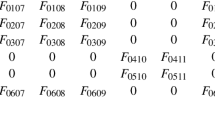Abstract
This paper deals with the establishment of anisotropic conjugate force based damage evolution laws in the framework of Rice's (1971) ‘normality structure’. The damage variable is the second-order crack tensor (Kachanov, 1980), which represents preexisting Griffith microcracks in a solid. The principal results include the deduced damage surfaces, potentials and kinetic equations for the basic internal variables and damage tensor during isothermal processes. The generalized pth order crack tensors and qth order energy release rates are introduced. The deduction in this paper is fully independent of the specific form of the free energy or Gibbs energy functions, so the deduced damage evolution laws have a wide applicable range including plasticity. Using the deviatoric stress as the conjugate force, the two well-established anisotropic yield surfaces, Karafillis and Boyce (1993) and Hill (1950), are recovered from the deduced damage surface.
Similar content being viewed by others
References
Basista, M. and Gross, D (1998). The sliding crack model of brittle deformation: An internal variable approach. International Journal of Solids and Structures 35, 487–507.
Bazant, Z.P. (1983). Comment on orthotropic models for concrete and geomaterials. Journal of Engineering Mechanics, ASCE 109, 849–865.
Brock, D. (1987). Elementary Engineering Fracture Mechanics, Martinus Nijhoff Publishers.
Budiansky, B. and O'Conne, R.J. (1976). Elastic moduli of a cracked solid. International Journal of Solids and Structures 12, 81–97.
Chow, C.L. and Chen, X.F. (1992). An anisotropic model of damage mechanics based on endochronic theory of plasticity. International Journal of Fracture 55, 115–130.
Chow, C.L. and Lu, T.J. (1989). On evolution laws of anisotropic damage. Engineering Fracture Mechanics 34, 679–701.
Dragon, A., Charlez, Ph., Pham, D. and Shao, J.F. (1993). A model of anisotropic damage by (micro) crack growth. Proceedings of the International Symposium on Assessment and Prevention of Failure Phenomena in Rock Engineering (Edited by A.G. Pasamehmetoglu et al.), Istanbul, Turkey, 71–78.
Erdogan, F. and Sih, G.C. (1963). Journal of Basic Engineering, ASME, 85, 519–527.
Hill, R. (1950). The Mathematical Theory of Plasticity, Clarendon Press, Oxford.
Hill, R. (1967). The essential structure of constitutive laws for metal composites and polycrystals. Journal of the Mechanics and Physics of Solids 15, 79–95.
Hill, R. (1979). Theoretical plasticity of textured aggregates. Proceedings of Cambridge Philosophical Society 85, 179–191.
Hosford, W.F. (1972). A generalized isotropic yield criterion. Journal of Applied Mechanics 39, 607–609.
Ju, J.W. (1989). On energy-based coupled elastoplastic damage theories: Constitutive modelling and computational aspects. International Journal of Solids and Structures 25, 803–833.
Kachanov, M. (1980). A continuum model of medium with cracks. Journal of Engineering Mechanics 106, 1039–1051.
Karafillis, A.P. and Boyce, D.B. (1993). A general anisotropic yield criterion using bounds and a transformation weighting tensor. Journal of the Mechanics and Physics of Solids 46, 85–113.
Kim, K.H. and Yin, J.J. (1997). Evolution of anisotropy under plane stress. Journal of the Mechanics and Physics of Solids 45, 841–851.
Krajcinovic, D., Basista, M. and Sumarac, D. (1991). Micromechanically inspired phenomenological damage model. Journal of Applied Mechanics 58, 305–316.
Krajcinovic, D. and Mastilovic, S. (1995). Some fundamental issues of damage mechanics. Mechanics of Materials 21, 217–230.
Lacy, T.E., McDowell, D.L, Willice, P.A. and Talreja, R. (1997). On representation of damage evolution in continuum damage mechanics. International Journal of Damage Mechanics 6, 62–96.
Lemaitre, J. (1990). A Course on Damage Mechanics, (2nd edn), Springer.
Lubarda, V.A., Krajcinovic, D. and Mastilovic, S. (1994). Damage model for brittle elastic solids with unequal tensile and compressive strengths. Engineering Fracture Mechanics 49, 681–697.
Lubarda, V.A., Krajcinovic, D. (1995). Constitutive structure of rate theory of damage in brittle elastic solids. Applied Mathematics and Computation 67, 81–101.
Malvern, L.E. (1969). Introduction to the Mechanics of a Continuous Medium, Prentice-Hall, Inc., Englewood Cliffs, N.J.
Mendelson, A. (1968). Plasticity: Theory and Application, Macmillan, New York.
Murakami, S. (1988). Mechanical modeling of material damage. Journal of Applied Mechanics 55, 280–286.
Oda, M., Suzuki, K. and Maeshibu, T. (1984). Elastic compliance for rock-like materials with random cracks. Solids and Foundations 24, 27–40.
Onat, E.T. (1984). Effective properties of elastic materials that contain penny shaped voids. International Journal of Engineering Science 22, 1013–1021.
Rice, J.R. (1971). Inelastic constitutive relations for solids: An integral variable theory and its application to metal plasticity. Journal of the Mechanics and Physics of Solids 19, 433–455.
Sih, G.C. (1973). A special theory of crack propagation. Methods of Analysis and Solutions of Crack Problems (Edited by G.C. Sih), Noordhoff International Publishing, Leyden, 22–45.
Swoboda, G., Yang, Q. and Zhou, W.Y. (1997). An energy-based damage models and its engineering application. Proceedings of the 9th International Conference on Computer Methods and Advances in Geomechanics, Wuhan, China, 1821–1828.
Valanis, K.C. (1971). A theory of viscoplasticity without a yield surface, Part I — General Theory. Archives of Mechanics 23, 517–533.
Valanis, K.C. (1975a). On the foundations of the Endochronic theory of viscoplasticity. Archives of Mechanics 27, 857–868.
Valanis, K.C. (1975b). Fundamental consequence of a new intrinsic time measure: Plasticity as a limit of the endochronic theory. Archives of Mechanics 32, 171–191.
Wu, C.H. and Aboutorabi, M.R. (1988). Endochronic modeling of coupled volumetric-deviatoric behavior of porous and granular materials. International Journal of Plasticity 4, 163–181.
Yang, Q. (1996). Numerical Modelling for Discontinuous Geomaterials Considering Damage Propagation and Seepage. Ph.D Dissertation, Faculty of Architecture and Civil Engineering, University of Innsburck, Austria.
Yu, S.W. and Feng, X.Q. (1997). Micromechanical damage model for brittle materials with residual strains. Proceedings of the Ninth International Conference on Fracture, Sydney, Australia.
Author information
Authors and Affiliations
Rights and permissions
About this article
Cite this article
Yang, Q., Zhou, W. & Swoboda, G. Micromechanical identification of anisotropic damage evolution laws. International Journal of Fracture 98, 55–76 (1999). https://doi.org/10.1023/A:1018787705489
Issue Date:
DOI: https://doi.org/10.1023/A:1018787705489




